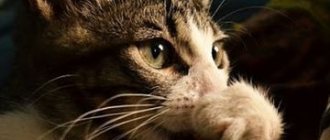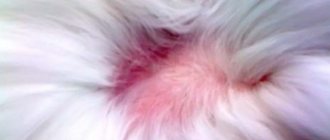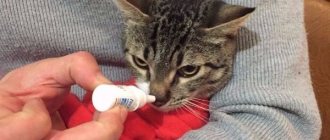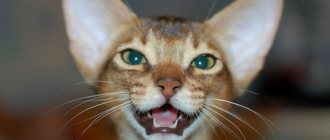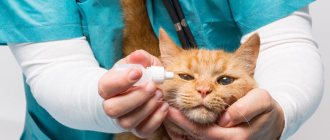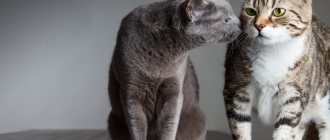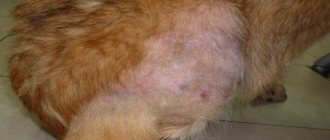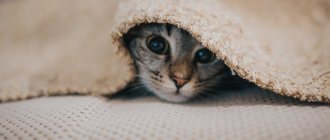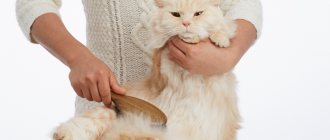In the article, we looked at why dandruff appears in cats, what are the external and internal causes, diagnosis and treatment options. You will also learn what folk remedies can help and preventive measures.
Cat dandruff
Dandruff in cats is common. This problem is characterized by disruption of the sebaceous glands, as well as detachment of skin scales. Dandruff has another name - seborrhea. It appears for reasons such as errors in care on the part of the owners, and disturbances in the functioning of internal organs. Pet owners are wondering whether this phenomenon is dangerous for their pet. We told you the reasons why dandruff may appear and how to deal with it.
What type of dandruff does cats have?
To choose a method of treating dandruff, it is worth knowing its types. It happens:
- Dry
- Fat
- Mixed
You can do a test to find out what type your cat has. Pet the animal and look at the hand. If the dandruff is easy to shake off, then it is dry. If there is a greasy mark on your hand, then it is oily.
The type of seborrhea can be determined by the type of hair. If the coat is dull, it is dry; if it is greasy, it is oily.
Owners are wondering if a cat can have black dandruff? The colors are gray, black and white. White means a disease of the internal organs. Black – damage by fungi and parasites.
Therapeutic techniques
The basic method of treating feline seborrhea is simple - the sick animal is washed thoroughly and regularly . Of course, not with clean water, but not with laundry soap either. Special shampoos are used for this . It is better to consult a veterinarian about their specific brand, since there are separate types of detergents for different types of seborrhea. Please note that washing alone can cure only the mildest cases of seborrhea, and even then only on condition that the disease is not complicated by another pathology.
In addition, humectants and emollients are used. If seborrhea is dry, they are prescribed without fail. As a rule, they are produced in the form of oils added to bathing water. Please note that you need to wash your cat in their solution for no more than 15-20 minutes, as otherwise the effect may be exactly the opposite.
These agents include: urea, sodium lactate, lactic acid and propylene glycol. Lactic acid is especially valuable. When used in small concentrations, it retains water in the epidermal layer. If the concentration is increased, the product acquires a keratolytic effect (dissolves rough scales of the epidermis and fur). For this reason, it is produced as part of separate drugs. Microperl Humectant spray has proven itself quite well.
Why does dandruff occur in cats?
Owners who have encountered seborrhea in their pet ask why this skin disease occurs? It appears for external and internal reasons. It depends on nutrition, hygiene and other factors. Dandruff appears due to a lack of nutrients necessary for the cat’s nutrition, damage by parasites, fungus, individual diseases, and improper care.
External causes depend primarily on the owner. In such cases, seborrhea appears due to improper care of the animal. Internal causes are associated with disruptions in the functioning of internal organs.
It is important to find out what caused the disease and then begin treatment. The treatment method is determined depending on the source of the disease.
Dandruff can appear on a cat's back due to a fungal infection, too dry air, or prolonged exposure to the sun.
Parasites in cats
External reasons
External causes of seborrhea are often errors in cat care. What can cause it?
- Frequent bathing
Washing your cat frequently
Owners can bathe their pet after every walk outside. But this cannot be done. Cats are naturally clean. They wash themselves every day on their own, so they do not need frequent bathing procedures. You need to bathe 2-3 times a year. If you wash too often, your skin can dry out, leading to dandruff.
- Poor grooming
You shouldn’t bathe your cat often, as written above, but you shouldn’t wash it at all. Unsanitary conditions have a bad effect on the skin and coat condition. Poor care can cause seborrhea. The animal needs to be bathed 2-3 times a year, and its fur must be combed with wooden combs and combs.
Infrequent scratching can cause seborrhea
- Poor quality care products
Cheap shampoos of poor quality can cause dandruff. Care products are chosen depending on the coat (thickness, length, sensitivity). The wrong shampoo can cause an allergic reaction. A good quality product includes non-aggressive surfactants, herbal extracts, vitamins, and antibacterial components.
- Bad comb or comb
Some combs injure the skin, which causes seborrhea. It is advisable to buy a comb made of natural bristles. It does not injure the skin, but takes gentle care.
Bad comb for combing
- Blow drying
It is not recommended to dry wool with a hairdryer. Dry skin causes seborrhea. The cat should dry naturally.
Internal reasons
- Poor nutrition
Poor nutrition
The first cause of seborrhea is an unbalanced diet. The cat may lack minerals, vitamins, macro- and micronutrients. Meals should include boiled meat, low-fat dairy products, vegetables and cereals. No need to give fatty, fried, spicy and sweet foods. You can also feed your pet with premium, super-premium or holistic dry food. They are a balanced diet.
- Excess weight
It can cause dandruff. Feeding standards must be observed. The food bowl should not be in the public domain. And also you should not feed food from the table. You need to decide how many times a day you will feed your pet. This figure depends on age, physical activity and weight. If excess weight causes health problems, it is worth taking the animal to the veterinarian.
- Side effects from taking medications
Side effects from taking medications
If dandruff appears after taking a medication, then it may be the cause of seborrhea. It is worth consulting with a doctor on how to treat your cat.
- Disease of internal organs
The cause of seborrhea can be disruptions in the body and disruption of the functioning of individual organs.
- Infections
Fungal diseases cause flaking, dullness and hair loss. Infection can occur through microcracks and diaper rash.
- Allergy
Perhaps the animal is allergic to food, bedding, etc.
Symptoms of seborrhea
There is no particular difficulty in suspecting seborrhea in your pet. The areas with a high concentration of sebaceous glands are the first to be affected - the lumbar region, sacrum and base of the tail. Dandruff can also be found on the animal's bedding or in its habitual sleeping area.
Also, one of the common signs of all types of dandruff is the presence of a moldy odor from the animal. It is quite sharp and difficult to confuse with something else. It is caused by the development of secondary microflora, and the more advanced the process, the more pronounced the smell.
Signs of dry seborrhea:
- Hypofunction of the sebaceous glands.
- Dry skin, increased peeling.
- Keratification of the epidermis.
Signs of oily seborrhea:
- Hyperfunction of the sebaceous glands.
- An accumulation of scales in a dense layer under the pet’s fur.
- The coat gets greasy quickly; in long-haired dogs, after a couple of days it hangs like icicles.
Oily seborrhea often occurs with complications, developing into dermatitis or eczema. It is worth paying attention to the condition of the folds in the paws and abdomen; very often acute inflammation processes can be observed in this area.
Seborrhea scales have a grayish or yellowish color. Many owners consider the appearance of black dandruff in dark-colored animals to be normal. But that's not true. The appearance of black scales indicates the development of a parasitic, fungal infection or acne.
Diagnosis of dandruff in cats
Diagnosis of dandruff in a cat
To cure an animal, you need to carry out a diagnosis. It starts with examining the pet. It is worth determining the type and color of dandruff. It’s also worth analyzing what you feed your pet and what care products you use. If you follow all the rules of care, then the reason may be inside the body. In this case, you need to consult a doctor.
The veterinarian will examine the animal and take the necessary tests (blood, hormones and biopsy). They will show the cause of seborrhea. Then the doctor will prescribe the necessary medications for treatment and tell you the features and details of care.
Clinical picture
As a rule, it usually starts with the appearance of a huge amount of dandruff . At first there is a lot of it along the animal’s spine; in advanced cases, the cat looks as if it had been pulled out of a snowdrift. In approximately 70% of true seborrhea (don't forget that it is not so common in cats), the first signs are visible before the age of two years.
If the cat is relatively lucky and everything is limited to dandruff, he will continue to walk around, showering everything around with “snow.” But in other cases, the skin and the fur itself gradually begin to become greasy with the secretion of “overexcited” sebaceous glands. The fur falls off in clumps and an oily sheen is clearly visible on the skin. But that's not all! Such conditions are simply heaven on earth for pathogenic and conditionally pathogenic microflora, representatives of which quickly infest the affected areas of the skin and begin to grow and develop intensively on them.
appear . But the real sign of “mature” seborrhea is the smell. The animal begins to smell frankly. If putrefactive microflora has joined the inflammation, then the cat smells like a bag of old garbage and even worse. In general, at this stage, even the most inattentive owners are simply forced to take their pet to the veterinarian, since it becomes absolutely impossible to be in the same room with him.
Treating a cat for dandruff
What to do if your cat has dandruff? Treatment occurs in different ways. Some suggest changing your diet and eliminating mistakes in skin care, others suggest taking medications. The second method is aimed at eliminating internal disorders and malfunctions of the body.
The method of treatment is prescribed by the doctor after examination. Test results will show the cause of seborrhea. Then the doctor will prescribe treatment and prescribe medications.
Dandruff treatment
Medications
Medicines are prescribed by a doctor, depending on the cause of seborrhea. The means are:
- Against parasites
- Against fungi
- Relieving itching
- Anti-inflammatory
Vitamin complexes
Your pet needs vitamins in the following cases:
- Unbalanced diet
- Special periods in a cat's life
- Period of illness and rehabilitation
- Increased physical activity
- Stress
Let's look at vitamin complexes that eliminate seborrhea.
- "Sherstevit"
Vitamins "Sherstevit"
The drug contains vitamin B1, sulfur, biotin, essential amino acids. The drug normalizes metabolism, accelerates hair growth, and reduces the impact of stress factors.
It is prescribed to prevent metabolic disorders.
Allowed for cats from two months of age. The medicine is given along with food. 1 tablet per 3 kg of weight. The dose can be increased depending on age, weight and breed. For small kittens, it is advisable to crush the tablet.
This drug has no contraindications if given according to dosage.
- "Farmavit Neo"
"Farmavit Neo"
This vitamin and mineral complex has been known on the market for more than 25 years. The drug contains vitamins, minerals, essential amino acids. Recommended for use in case of unbalanced diet. Farmavit Neo enriches the diet with essential nutrients during periods of stress and pregnancy. It is also needed to prevent metabolic disorders.
Farmavit Neo includes macro- and microelements (calcium, phosphorus, iodine), 11 vitamins, amino acids (taurine, methionine, L-carnitine), biologically active components (prebiotic inulin, spirulina, microcellulose).
The drug is effective because it was tested on groups of 132 cats. The result showed that 79% self-administered the medicine.
- "Beaphar"
Vitamins "Beaphar"
The company provides a large selection of antiparasitic agents and vitamins.
- "VEDA Phytomins"
Vitamins "Phytomins VEDA"
The drug includes natural minerals, biologically active substances (L-carnitine, taurine, lecithin, albumin), plant phytocomplex. The medicine helps cope with various diseases, strengthens the immune system, and increases the vital complex.
- "Radostin"
The complex contains biologically active substances, unique prebiotics, hydrolyzed White Sea mussels, taurine. The drug normalizes digestion processes, improves the functioning of the nervous system, increases the tone and resistance of the animal’s body to diseases.
- "Polidex Multivitum"
The medicine includes a complex of vitamins, macro- and microelements, amino acids necessary for kittens. It improves health and well-being, improves immunity, and speeds up metabolism.
Treatment of seborrhea in a kitten
The appearance of seborrhea does not depend on age. Dandruff can also appear in a kitten due to an unbalanced diet, improper grooming, or disruption of the internal organs.
If your baby has seborrhea, you need to identify the cause. Analyze your actions to care for your pet's coat and feed the animal.
Eliminate dietary errors. Feed your baby premium, super-premium or holistic dry food. If the dandruff does not go away, contact your veterinarian.
Medicinal anti-dandruff shampoos for cats
Good quality products contain non-aggressive surfactants that eliminate fat but do not dry out the skin. Shampoo may contain antibacterial additives that eliminate unpleasant odors and relieve dermatological problems. If the animal does not like bathing, you can purchase a special spray.
Let's look at examples of good quality shampoos.
- "Api-San"
Shampoo "Api-San"
This is a medicated shampoo with a sulfate-free formula. The product prevents the development of bacteria, including fungus. Sometimes dandruff disappears after the second wash.
- "CitoDerm"
Anti-dandruff shampoo CytoDerm
The shampoo relieves itching, irritation, and allergies.
- "Celandine"
“Clandestine”
Shampoo “Clandestine” makes the coat soft, shiny, and makes combing easier. The product is inexpensive and can be found in many pet stores.
- "Doctor Zoo"
Doctor Zoo shampoo strengthens hair, makes combing easier, and also gets rid of parasites.
- "Beekeeper"
The shampoo is suitable for individuals with light coat color. It contains components to enhance the natural color of the coat. The shampoo nourishes and moisturizes the coat, prevents flaking and dryness, and eliminates dermatological problems.
- "Phytoelite"
The shampoo relieves itching, adds shine to the coat, heals cracks, and prevents dryness.
Pathogens and causes of the disease
The causative agent of the disease is mites of the genus Cheyletiella, which spend their entire life cycle on the host, or more precisely, on his skin.
It is here that cheyletiella undergoes six stages of development:
- The fertilized eggs laid by the female are secured by the female to the animal's hair using thin silky threads, forming a kind of cocoon.
- After an incubation period of 3-4 days, six-legged larvae are born.
- After 7.5 days they turn into protonymphs, but with 8 legs.
- After another 4-5 days, the protonymphs turn into 8-legged deutonymphs.
- After another 5 days, the deutonymphs enter the adult stage.
- They then develop into adult ticks, females and males that are whitish-yellowish in color and live for about 14 days.
Thus, the complete life cycle of the parasite fits into the period of 21-35 days. However, it should be remembered that adult ticks are capable of existing outside the host: in females, the period of autonomous existence is up to 10 days, in males – up to two days.
Mites live on the surface of the skin, without going deep into the epidermis. They feed on tissue fluid, to obtain which they make punctures with chelicerae - a kind of claw-like appendage.
Cheyletiellosis is a highly contagious disease that is instantly transmitted from an infected animal to a healthy one. Its danger also lies in the fact that in some cases no external characteristic signs are noticeable on an infected animal, but it is capable of infecting everyone with whom it comes into contact.
We should also not forget that adult ticks can exist autonomously, that is, without a host, for quite a long time, and when a suitable object appears, they immediately settle on it.
Folk remedies
Herbal decoctions
Some owners do not trust modern means, but prefer traditional medicine.
One method is to rub olive or burdock oil into the coat. Oils accelerate the growth of hair follicles, strengthen the coat, and restore metabolism. It is recommended to regularly rub oil into the roots.
Cat owners also recommend herbal medicine. Once every two days, you can rub herbal decoctions into the roots (seed, burdock, calendula, nettle, coltsfoot).
Complications
If seborrhea is not treated promptly, complications may occur. These include purulent dermatitis and eczema.
Dermatitis in cats
Purulent dermatitis manifests itself in the form of ulcers. The causes of this disease are infections, hormonal imbalance, parasites, and a decline in the immune system. Signs of dermatitis can include rash, inflammation, itching, and ulcers.
If you have symptoms of dermatitis, you should take your cat to the vet. The doctor will take tests, identify the cause, and prescribe treatment. This could be a special diet or medication.
Another skin disease that seborrhea can lead to is eczema. It manifests itself in the form of flaky patches of skin. Eczema can be wet or dry. Wet looks like pus, and dry looks like a rash, blisters and crusts from scratching.
This skin disease is accompanied by itching and increased body temperature.
Predisposing factors
They are extremely diverse. Causes of secondary seborrhea include: scabies and other “mite-borne” diseases, flea dermatitis, food allergies, atopy, pyoderma and malassezia. Let us note that all varieties of this disease can be divided into two large groups: in some cases the disease is accompanied by itching, in others it does not occur (or it does occur, but it is very mild). The causes of these conditions are usually different, which must be taken into account when diagnosing.
So, seborrhea, accompanied by itching , can develop due to the following reasons: demodicosis; dermatomycosis, endocrine diseases (hypothyroidism, Cushing, imbalance of sex hormones). Possible foliar pemphigus, mycosis (by the way, itching can be catastrophically severe in these pathologies), seborrhea often develops in cats receiving corticosteroids for a long time, as well as in those pets whose food contains very little or no polyunsaturated fatty acids, vitamins and microelements .
If seborrhea is not accompanied by itching (or it is mild), it can be caused by the following diseases: dermatosis caused by a lack of provitamin A, epidermal dysplasia, sebaceous adenitis, follicular dystrophy, and ichthyosis.
Be that as it may, if there is any suspicion of seborrhea, it is necessary to exclude other diseases whose symptoms may be similar. In the differential diagnosis, the following are excluded/confirmed: lichen-like psoriasiform dermatosis (usually affecting the ears), “zinc” dermatosis (caused by zinc deficiency), hyperkeratosis. In addition, seborrhea “without pruritus” is often idiopathic. That is, its causes are not known; most likely, this type of pathology is hereditary and has some kind of genetic background.
Prevention of dandruff in cats
Beautiful wool
It is important to follow all skin care and nutrition rules to prevent skin diseases. These simple rules of prevention will not lead to various skin problems:
- Choose coat care products, a comb, and good quality litter to avoid allergic reactions.
- Watch your diet. The diet should include micro- and macroelements, vitamins, and minerals. Avoid fried, fatty, spicy, sweet foods.
- Don't bathe your pet too often. Excessive washing dries out the skin and causes skin diseases. Bathing too infrequently is also not beneficial. You need to wash it 2-3 times a year, and also comb the coat so that tangles do not form.
- Ventilate the room so that there is always fresh air in the room.
- Stay hydrated.
- Check regularly for fleas and other parasites.
- Avoid stress. Play with the animal, give it your time and attention.
